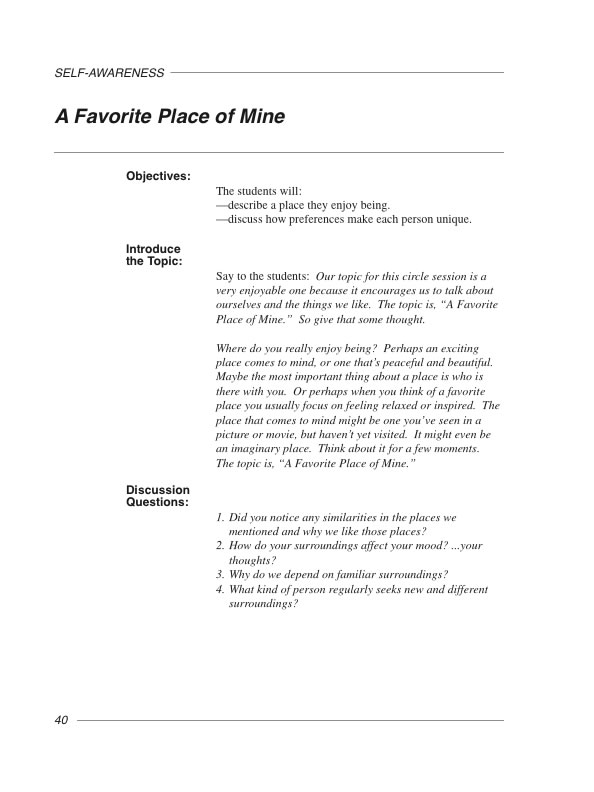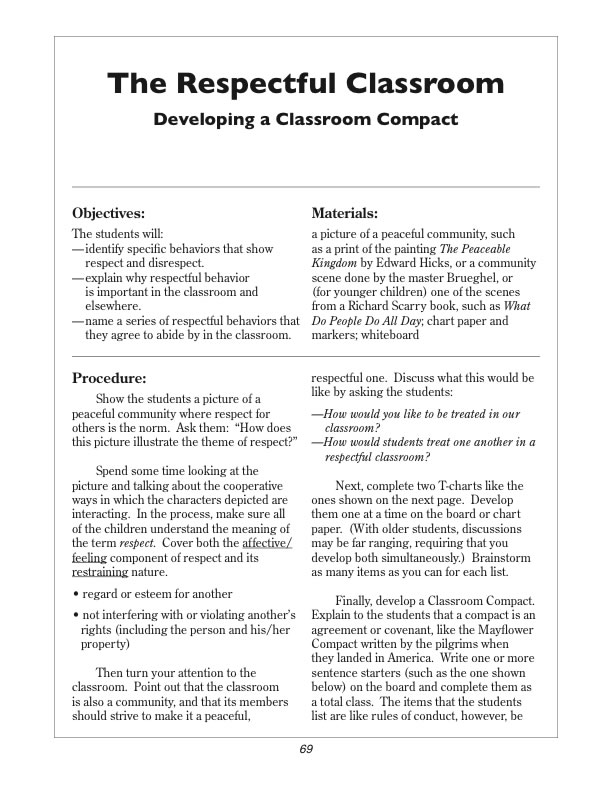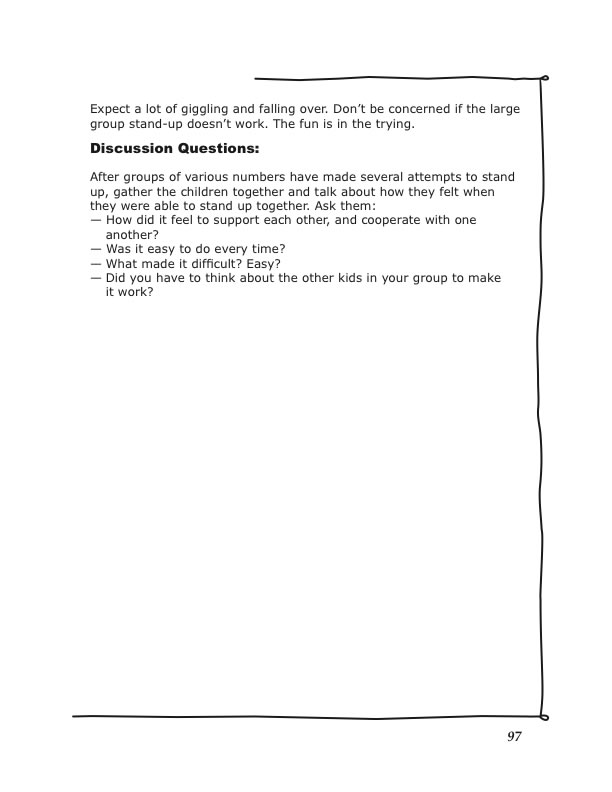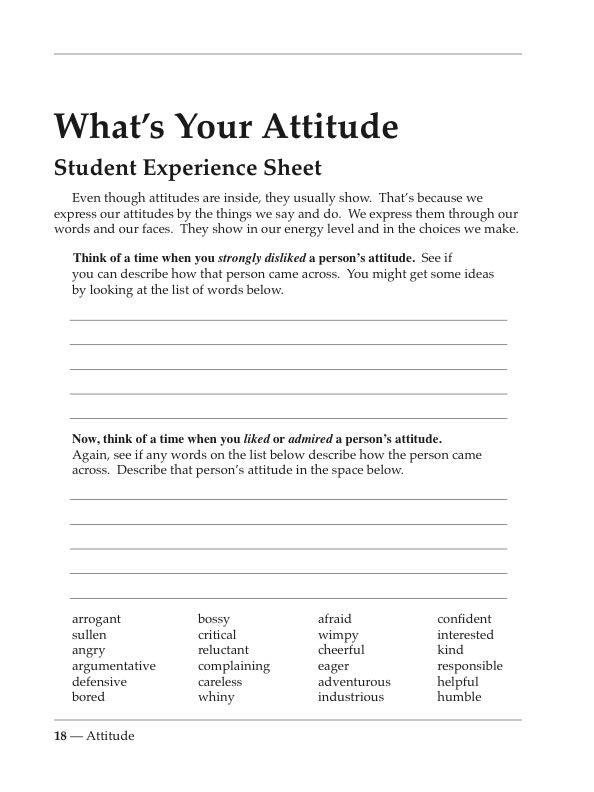The Importance of Relating Well With Students
Most educators today are aware of the benefits of creating and maintaining positive relationships with students. Meaningful relationships do matter. All people want to feel valued and cared for by others, and to be listened to in a non-judgemental manner. Students are no different. Students especially want their teachers to treat them with respect, to appreciate their feelings, desires, hopes and dreams and to recognize them as unique individuals.
Mounting research says that positive teacher-student relationships are the basis for a positive school experience. It increases student motivation and engagement while decreasing the challenges of discipline, absenteeism, and drop out rates. A caring, affirming relationship between teacher and student is the key to this positive learning environment.
How Good Relationships Are Created
Positive relationships are developed in many ways large and small. Showing interest, smiling often, really listening to their concerns, providing positive reinforcement, and acknowledging effort all contribute to relationship building. The process of verbal interaction, coupled with attention and acceptance, is a key avenue to establishing and maintaining positive relationships. It’s through this verbal exchange that you get to know your students as individuals, what they care about, what their interests are, their hopes for the future, what they might be struggling with right now, and how their cultural backgrounds and life experience impacts their school life.

Engaging in meaningful conversation with your students is vitally important to making them feel you care. Creating goodwill and positive connections don’t happen readily when attempted on a haphazard basis, but should be a regular, imbedded part of a classroom or group setting. Sharing Circles provide a smooth, easily implemented strategy for creating just such an experience. Through the emotional safety of sharing established in the Sharing Circle process to the provided topics which cover the whole range of human experience, the circle assists you in getting to know your students as individuals, to learn what’s important to them, their backgrounds and culture, their strengths and challenges. You get to know who they are in all their unique dimensions. Another important aspect is that you, as the teacher or counselor, get to share about yourself too. It’s by sharing your humanity with your students that you create a two way bond of mutual caring and concern.
Here’s a wonderful Sharing Circle from The Sharing Circle Handbook our complete guide to everything you need to know to have success with Sharing Circle Topics
 Here’s Your Sharing Circle. Enjoy!
Here’s Your Sharing Circle. Enjoy!

Do you want more information?
• Leading a Sharing Circle
• Sharing Circle Rules
• Books and Resources
• Free Activities
• Subscribe
Go here:
Here’s How It’s Done
Gather everyone into a circle. Explain the rules for sharing, and get agreement from everyone that they will follow the rules.
Sharing Circle Rules:
- Everyone gets a turn to share, including the leader.
- You can skip your turn if you wish.
- Listen to the person who is sharing.
- There are no interruptions, probing, put-downs, or gossip.
- Share the time equally.
After everyone has shared, who wants to share, ask the discussion questions.
You can check the book out HERE.
Just click HERE to open a fully reproducible PDF of this activity and experience sheet…
If you like our blog resources and would like to receive them regularly, please subscribe here or on our website at www.InnerchoicePublishing.com
If you are already a subscriber, I hope you find this activity valuable. Help us grow our blog by sharing these activities and encouraging others to join. Thank you.
Thanks so much for reading!
Susanna
[New Post] Building An Emotional Vocabulary in Children
Why An Emotional Vocabulary Is Important
Helping children build an emotional vocabulary encourages a firm foundation in social and emotional competence. Being able to identify what you are feeling and to be able to effectively understand what others are feeling is a necessary part of social awareness. In order to correctly identify feelings in yourself and others you first have to have words for those feelings. There is a large and varied vocabulary of emotions and feeling words beyond happy, sad, and mad. People of all ages need an assortment of words for their feeling vocabulary in order to express their feelings well, and to be able to read and respond appropriately to the emotional cues coming from others. A feeling vocabulary that is large and complex permits children to discriminate between feelings and to effectively communicate to others what they are experiencing. Being able to accurately identify and label feelings in others allows children to understand and successfully manage social situations.
How An Emotional Vocabulary Develops

Children acquire this vocabulary of self-awareness and social-awareness by direct instruction and by observing what’s happening around them. Many experiences, both purposeful and happenstance, help children develop an extensive feeling vocabulary. Hearing feeling words used around them, having stories read to them that use rich vocabulary, and participating in social activities all encourage children to expand and label their feelings appropriately. In today’s classrooms and counseling groups the development of social and emotional skills and related vocabulary should be fostered in multiple ways and through presenting a variety of activities. Today’s blog activity comes from the book, Social and Emotional Learning Activities For The Elementary Grades, and provides an effective way to expand the feeling vocabulary of your students.
Here’s Today’s Activity and Experience Sheet



You can check the book out HERE.
Just click HERE to open a fully reproducible PDF of this activity and experience sheet…
If you like our blog resources and would like to receive them regularly, please subscribe here or on our website at www.InnerchoicePublishing.com
If you are already a subscriber, I hope you find this activity valuable. Help us grow our blog by sharing these activities and encouraging others to join. Thank you.
Thanks so much for reading!
Susanna
[New Post] The Importance of Listening to Your Students
Many of us don’t realize that by simply listening to students talk and share their inner thoughts and issues we can immensely facilitate their personal development. It’s by sharing their thoughts and feelings and experiences openly and in a non-judgmental setting that students gain important life skills and self-knowledge. Once they see that we do not intend to “change” them and that they may speak freely without being “wrong,” students find it easier to examine themselves and begin to see areas where they can make positive change in their lives. It’s through sharing and being truly listened to that students clarify their thoughts, and learn effective methods of self-expression. With this kind of true listening they are encouraged to go deeper, find their own direction, and express and face strong feelings that may at other times be hidden obstacles to their growth. The important point is that students really can solve their own problems, develop self-awareness, and learn skills that assist them in becoming responsible members of society if they are listened to effectively.
The Perfect Strategy
The Sharing Circle, which provides both the opportunity for students to be listened to, and to listen to others, is the prime teaching tool that we have developed in our curriculum guides to foster these valuable life skills in all students K – 12.

A Listening Forum
Just as the Sharing Circle provides a process for students to learn about themselves through self-expression and exploration, it also teaches students to be good listeners. The rules of the Sharing Circle (listening to the person who is speaking, without probing, put-downs, or gossip) demand that each student give active attention to the speaker. Through the regular practice of good listening by the teacher or counselor leading the circle, the students begin to internalize good listening habits.
Your Sharing Circles
Today we are providing two Sharing Circle topics designed to promote good listening from The Sharing Circle Handbook, Topics for Teaching Self-Awareness, Communication, and Social Skills for students in grades K-12. The topics are, Something I Like to Do Alone and Something I Like to Do With Other People.
 Here’s Your Monday Morning Sharing Circle. Enjoy!
Here’s Your Monday Morning Sharing Circle. Enjoy!

Do you want more information?
• Leading a Sharing Circle
• Sharing Circle Rules
• Books and Resources
• Free Activities
• Subscribe
Go here:
Here’s How It’s Done
Gather everyone into a circle. Explain the rules for sharing, and get agreement from everyone that they will follow the rules.
Sharing Circle Rules:
- Everyone gets a turn to share, including the leader.
- You can skip your turn if you wish.
- Listen to the person who is sharing.
- There are no interruptions, probing, put-downs, or gossip.
- Share the time equally.
After everyone has shared, who wants to share, ask the discussion questions.
You can check the book out HERE.
Just click HERE to open a fully reproducible PDF of this activity and experience sheet…
If you like our blog resources and would like to receive them regularly, please subscribe here or on our website at www.InnerchoicePublishing.com
If you are already a subscriber, I hope you find this activity valuable. Help us grow our blog by sharing these activities and encouraging others to join. Thank you.
Thanks so much for reading!
Susanna
A Quality of Friendship

In keeping with our last blog here’s another activity to expand children’s repertoire of friendship skills. Being able to cooperate and give support to our friends conveys how we feel toward and are going to behave with our friends. This is one of the things we DO for and with our friends.
What Friends Do
Once again this week’s activity, Friends Support Each Other, is a cooperative game that comes from our book, Social Skills Activities for the Elementary Grades. Enjoy!

You can check the book out HERE.
Just click HERE to open a fully reproducible PDF of this activity and experience sheet…
If you like our blog resources and would like to receive them regularly, please subscribe here or on our website at www.InnerchoicePublishing.com
If you are already a subscriber, I hope you find this activity valuable. Help us grow our blog by sharing these activities and encouraging others to join. Thank you.
Thanks so much for reading!
Susanna
Helping Kids Make Friends
Cooperation, support, and having fun together are some of the things we experience with our friends. Our network of friends is one of the most important areas in which we develop social awareness. Children learn skills for interacting with others through successful interaction with their peer group. And having friends to care for and rely on can help them cope effectively with life’s daily challenges.
This week’s Sharing Circle and next week’s group activity both teach friendship skills and are designed to help students develop the ability to establish and maintain friendships.
Your Resources
Both this Sharing Circle and next week’s activity are taken from our book, Social Skills Activities for the Elementary Grades. Enjoy! The topic is, Something I Do to Keep a Friend.
 Here’s Your Monday Morning Sharing Circle. Enjoy!
Here’s Your Monday Morning Sharing Circle. Enjoy!

Do you want more information? • Leading a Sharing Circle • Sharing Circle Rules • Books and Resources • Free Activities • Subscribe
Here’s How It’s Done
Gather everyone into a circle. Explain the rules for sharing, and get agreement from everyone that they will follow the rules.
Sharing Circle Rules:
- Everyone gets a turn to share, including the leader.
- You can skip your turn if you wish.
- Listen to the person who is sharing.
- There are no interruptions, probing, put-downs, or gossip.
- Share the time equally.
After everyone has shared, who wants to share, ask the discussion questions.
You can check the book out HERE.
Just click HERE to open a fully reproducible PDF of this activity and experience sheet…
If you like our blog resources and would like to receive them regularly, please subscribe here or on our website at www.InnerchoicePublishing.com
If you are already a subscriber, I hope you find this activity valuable. Help us grow our blog by sharing these activities and encouraging others to join. Thank you.
Thanks so much for reading!
Susanna
Awareness of Self and Others
Awareness is a critical element in life-skill development. Aware people do not hide things from themselves. They are in touch with the inner world of their feelings and thoughts, and they are in control of their actions—and they understand that other people feel, think, and behave too. They are also in touch with the reality of the past, the possibilities of the future, and the certainty of the present. Awareness allows individuals to order their lives flexibly and effectively on a moment-to-moment basis. Awareness also allows us to connect with others and is fundamental to developing empathy.
Here’s a Sharing Circle That Focuses on the Nature of Awareness
This Sharing Circle topic comes from the activity book (Grades 4-12), 101 Life-Skills Discussion Topics. The topic is, A Favorite Place of Mine.
 Here’s Your Monday Morning Sharing Circle. Enjoy!
Here’s Your Monday Morning Sharing Circle. Enjoy!

Do you want more information? • Leading a Sharing Circle • Sharing Circle Rules • Books and Resources • Free Activities • Subscribe
Here’s How It’s Done
Gather everyone into a circle. Explain the rules for sharing, and get agreement from everyone that they will follow the rules.
Sharing Circle Rules:
- Everyone gets a turn to share, including the leader.
- You can skip your turn if you wish.
- Listen to the person who is sharing.
- There are no interruptions, probing, put-downs, or gossip.
- Share the time equally.
After everyone has shared, who wants to share, ask the discussion questions. Get more in-depth information here.
Just click HERE to open a fully reproducible PDF of this Sharing Circle activity…
If you like our blog resources and would like to receive them regularly, please subscribe above or on our website at www.InnerchoicePublishing.com
If you are already a subscriber, I hope you find this activity valuable. Help us grow our blog by sharing these activities and encouraging others to join.
Thank you. Thanks so much for reading!
Susanna
Teaching Kindness
Today’s blog was inspired when I was sharing a meal the other day with a teacher friend. I asked how the new school year was starting out, and she shared that a challenge was getting the students to be kind to one another. I thought that providing a kindness activity today seemed the perfect response.
Kindness and Its Importance
Everyone intuitively knows the value of being kind, and teaching kindness and empathy to children. Observing or participating in acts of kindness sets a positive and caring tone for the day as well as reinforces important social-emotional skills. Modeling and reinforcing kindness makes it a practical and commonplace skill.
Many benefits have been reported in support of directly teaching kindness in schools including: Happy caring children; Greater sense of belonging and improved self-esteem; Improved health and less stress; increased feelings of gratitude; Better concentration; Reduced depression; Less bullying. In a 2016 report the US Department of Education said that research demonstrates the importance of kindness: “Students learn best when they feel safe, supported, challenged and accepted”. These are all elements of kindess.
Here’s Your Kindness Resource
This week’s activity helps students learn about the richness found in kind acts and behaviors and how they can be a benefit to all aspects of their lives. The activity, A Book of Kindness, comes from the resource guide, Caring and Capable Kids.

You can check the book out HERE.
Just click HERE to open a fully reproducible PDF of this activity and experience sheet…
If you like our blog resources and would like to receive them regularly, please subscribe here or on our website at www.InnerchoicePublishing.com
If you are already a subscriber, I hope you find this activity valuable. Help us grow our blog by sharing these activities and encouraging others to join. Thank you.
Thanks so much for reading!
Susanna
Helping Students Develop Positive Attitudes
It’s All About Attitude
It has been said that life is forty percent what we make it, and sixty percent how we take it. Whatever the ratio, the point is clear that attitude is a defining lens. We always have a choice about how we respond to events in our lives.
To recognize the benefits of developing positive, responsible attitudes, young people must first grow in self-awareness. They must learn to understand feelings and their relationship to thoughts, and they must understand that their own feelings are normal, predicable, and susceptible to control. Feelings convey messages about conditions and events going on in the environment, and provide important clues to the way the brain is processing information.
As William James said over one hundred years ago, “Human beings, by changing the inner attitudes of their minds can change the outer aspects of their lives.”
A Tool You Can Use
This week’s activity helps students learn about the power of their attitudes – how negative attitudes cause problems and how positive attitudes can be a benefit to all aspects of their lives. The activity, Developing a Positive Attitude, has two parts – a group discussion followed by an experience sheet.

You can check the book out HERE.
Just click HERE to open a fully reproducible PDF of this activity and experience sheet…
If you like our blog resources and would like to receive them regularly, please subscribe here or on our website at www.InnerchoicePublishing.com
If you are already a subscriber, I hope you find this activity valuable. Help us grow our blog by sharing these activities and encouraging others to join. Thank you.
Thanks so much for reading!
Susanna
How I Show Respect Toward Others
Reflections on Respect Here’s a follow up on last week’s Blog which discussed the importance of teaching students the value of respect. Helping students understand the significance of a respectful attitude and helping them identify specific actions and behaviors that demonstrate respect is the purpose of today’s Sharing Circle. This Sharing Circle topic comes from the activity book (Grades 3-6), Hearts and Minds – An After-School Program for Developing Reading Literacy and Emotional Intelligence. The topic is, How I Show Respect Toward Others…
Here’s a follow up on last week’s Blog which discussed the importance of teaching students the value of respect. Helping students understand the significance of a respectful attitude and helping them identify specific actions and behaviors that demonstrate respect is the purpose of today’s Sharing Circle. This Sharing Circle topic comes from the activity book (Grades 3-6), Hearts and Minds – An After-School Program for Developing Reading Literacy and Emotional Intelligence. The topic is, How I Show Respect Toward Others…
 Here’s Your Monday Morning Sharing Circle. Enjoy!
Here’s Your Monday Morning Sharing Circle. Enjoy!
Do you want more information? • Leading a Sharing Circle • Sharing Circle Rules • Books and Resources • Free Activities • Subscribe
Here’s How It’s Done
Gather everyone into a circle. Explain the rules for sharing, and get agreement from everyone that they will follow the rules.
Sharing Circle Rules:
- Everyone gets a turn to share, including the leader.
- You can skip your turn if you wish.
- Listen to the person who is sharing.
- There are no interruptions, probing, put-downs, or gossip.
- Share the time equally.
After everyone has shared, who wants to share, ask the discussion questions. Get more in-depth information here.
Just click HERE to open a fully reproducible PDF of this Sharing Circle activity…
If you like our blog resources and would like to receive them regularly, please subscribe above or on our website at www.InnerchoicePublishing.com
If you are already a subscriber, I hope you find this activity valuable. Help us grow our blog by sharing these activities and encouraging others to join.
Thank you. Thanks so much for reading!
Susanna
Activities for Teaching Respect
Teaching children about respect and developing positive relationships is one of the most important things we can do, especially in today’s increasingly disrespectful world.
What It Takes
Being intentional and specifically having your students engage in activities focussed on respect will help them to understand the importance of their respectful actions and to understanding the difference between respectful and disrespectful actions and words.
Respect means showing regard for the worth of someone or something. It includes respect for self (self-esteem), respect for others, and respect for the environment, including other life forms. All other varieties of respect are outgrowths of these three. Respecting someone’s property, for example, extends from respecting the owner of the property.
When we teach students to show respect, we prevent them from hurting what they ought to value. If we are completely successful, they will end up valuing that for which they have demonstrated respect.
Other ways to foster respect include:
- Create a democratic classroom environment, in which the rights of all students are respected. Show your own regard for every student, every day.
- Expect students to be polite and courteous. Consistently model the use of “please,” “thank you,” “excuse me,” etc.
- Really listen to the opinions and contributions of students. Make it a rule that students listen respectfully to each other.
- Show your appreciation for diversity. Create an environment in which individual differences are celebrated, and where all students feel included and interdependent.
- Teach students a simple decision-making process and encourage them to use it. Respect their ability to make decisions for themselves. Serve as their advisor and consultant.
- When students have difficulty understanding how their behavior affects others, suggest that they apply the classic test of reversibility. Ask them: Would you want to receive this kind of treatment?
Here’s a great activity for working on one important aspect of RESPECT:


You can check the book out HERE.
If you like our blog resources and would like to receive them regularly, please subscribe here or on our website at www.InnerchoicePublishing.com
If you are already a subscriber, I hope you find this activity valuable. Help us grow our blog by sharing these activities and encouraging others to join. Thank you.
Thanks so much for reading!
Susanna











